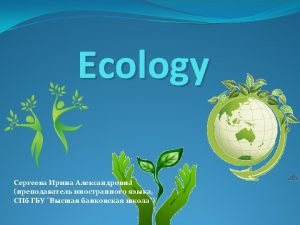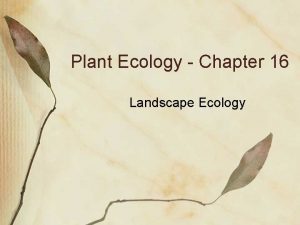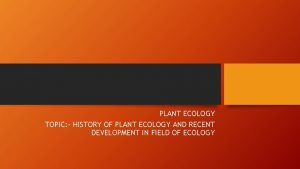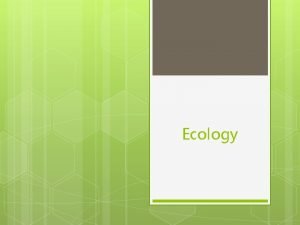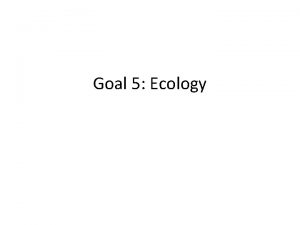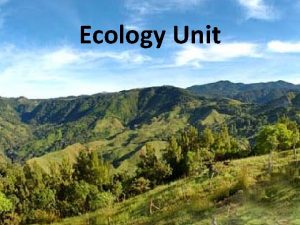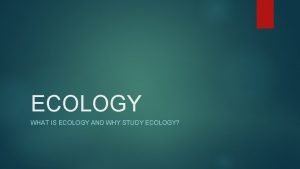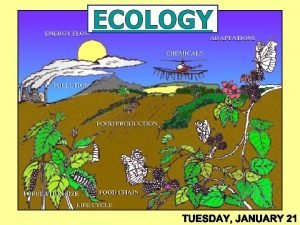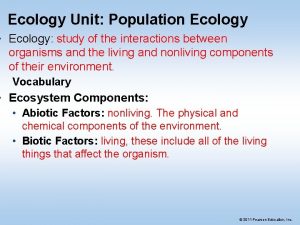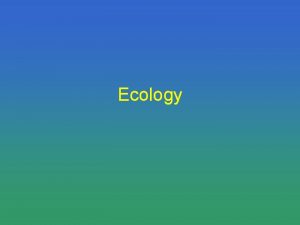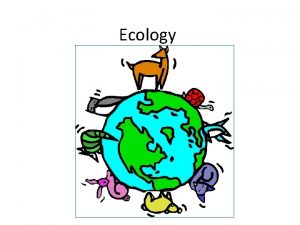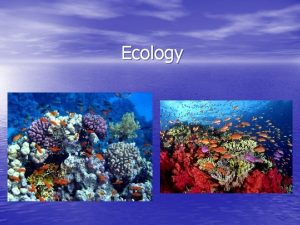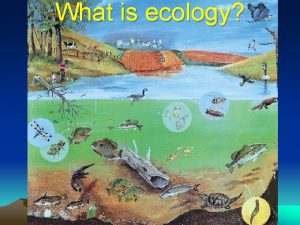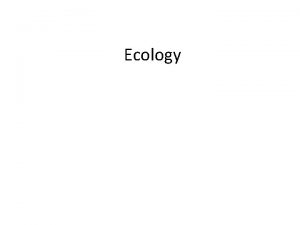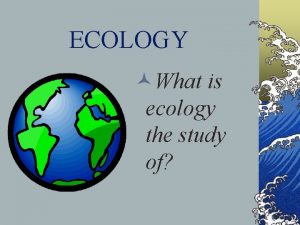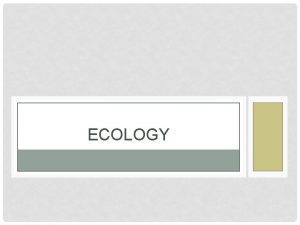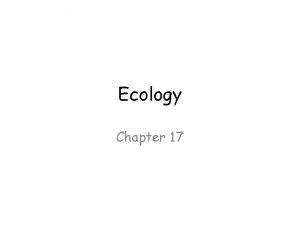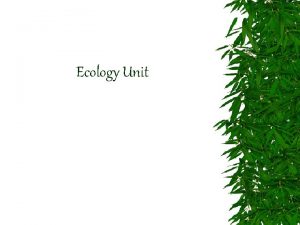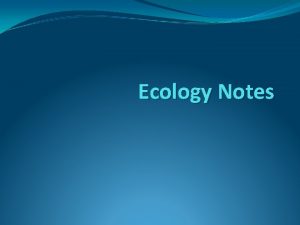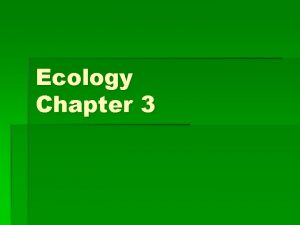Plant Ecology Plant ecology is the study of








































- Slides: 40

Plant Ecology Plant ecology is the study of the distribution and abundance of plants, and the reasons why those distributions and abundances occur. It’s a huge subject, with aspects taught in a full semester course with “Plant Ecology” as its title. So in one lecture you’ll get only a few interesting highlights. Radically different communities are found in different parts of the earth. The different types are usually summarized by their plant communities, organized into biomes.


Climates define the regions in which these different biomes will occur: • Tropical rain forest –

Tropical rainforests are equatorial (within ~5º latitude of the equator), • always moist, with almost daily rainfall, and • no seasonal change in temperature. The plant community is described as evergreen. Products include: • lumber for expensive furniture (rosewoods, teak, mahogany) • drugs like Vincristine from Madagascar rose periwinkle, probably many as yet undiscovered • in deforested areas where pastures have been grown, Mc. Donald’s Big Macs.

Temperate deciduous forest -

Temperate deciduous forest occurs with moderate conditions and winter freezing. An adaptation to freezing conditions is to drop their leaves (be deciduous). • However, in drier portions, there are coniferous forests (southeastern U. S. long-leaved pines) that do not drop their needles • Precipitation occurs continuously throughout the year, with an annual total of 75 – 150 cm. Products: construction and furniture lumber (oaks, hickories, birches, elm, maples), fruits (cherries, apples, plums)

Temperate grassland (prairie) -

Grasslands get less precipitation than deciduous forests, though they occur at the same latitudes. Total annual precipitation 25 – 50 cm. Temperature: summers are hot and winters cold. Grassland regions typically have deep rich organic soils. As a result, much of the biome has been converted to agriculture. Products: grains (corn, wheat), seed oils (sunflower, safflower), cattle, hogs raised on pastures

Deserts –


Grasslands grade into deserts as precipitation decreases. Deserts get <50 cm total precipitation per year. They mostly occur around 30º N and S latitude: Sonoran, Chihuahuan and Mohave in North America, Atacama in South America, Sahara and Kalihari in Africa, Central in Australia, and high, cold Gobi in Asia. Adaptation to low precipitation: reduce leaves to needles, lowers transpiration losses. Products: guayule latex rubber, jojoba seed oil, and a number of foods, e. g. nopalitos (cactus pads, for the uninitiated), cactus seed pods.

Suguaro cactus needles – Sonoran desert Crown of thorns Euphorb – Kalihari desert, South Africa

Boreal forest (also called taiga or coniferous forest) –

Boreal forest occupies the largest land area of all the biomes, along a broad belt beginning at 50º N latitude in N. America and closer to 60º N in Europe (due to the warming effect of the Gulf Stream). • Average annual temperature <5º C. • Average annual total precipitation 40 -100 cm. • Slow decomposition of fallen needles makes soils acidic • Growing season is 100 days or less • Low diversity Products: commercially limited to pulp for making paper, but hunting and fishing as well

Tundra -

Tundra comes from a Russian word meaning “treeless”. It can also be defined as having only surface soil (up to around 1 m) ‘melt’ during summer, so that beneath is a permanently frozen zone called permafrost. Precipitation is less than 60 cm per year, but since the precipitation can’t drain through soil, the surface is wet, and soil remains saturated through the growing season. Growing season is very short, less than 100 days at the southern margin, down to around one month further north.

There are more biomes, but none of an importance or extent as large as these. A biome is a very coarse subdivision of the living world. Species that characterize a biome in one part of the world are much different than those that characterize another example of the biome somewhere else. Each region has its own native species. When species are translocated from one version of a biome to another, they are called non-native, alien, non -indigenous, introduced, exotic, or various other (frequently unprintable) names. They all-to-frequently become pests and problems. A few examples:

Australia has been the ‘test bed’ for a number of problematic introductions. Cattle ranchers, apparently to save themselves the cost of installation and maintenance of barbed wire fences over long distances, introduced prickly pear cactus to form ‘natural’ fences. It soon grew to occupy thousands of hectares of then unusable pasture. After a number of years, biologists found a biological control agent, a moth called Cactoblastis cactorum.

This is what a cactus pad looks like after the moth has laid its eggs on the pad, and the larvae have burrowed into and eaten the inside of it. Successful control!

Kudzu is native to Japan and China. It was introduced into N. America in 1876 at a Philadelphia Centennial Exposition, then into Florida early in the 20 th century (~1908) as a forage crop for livestock. Kudzu is a vine that when left uncontrolled will eventually grow over almost any fixed object in its proximity including other vegetation, or even buildings.

There is no currently known biological control agent. Control can potentially be achieved by repeated mowing, slowly exhausting energy storage in the root system, and by application of systemic herbicide to the cut end of the root. That sounds simple enough, but to understand how hard it is on a large scale, plants grow by 1 foot per day. You can, with only a little patience, actually see it growing.

Purple loosestrife, Lythrum salicaria, is native to Europe and Asia. It was introduced into North America in the 1800 s in dry ship ballast and/or as an ornamental plant. A single mature plant can produce 2. 5 million seeds annually. Environmental conditions for seed success are far more limited than for continued plant growth. Adult plants can tolerate even permanent flooding. They are, therefore, mainly a problem in wetland areas, where they outcompete native vegetation. Purple loosestrife is now found in 9 provinces and all states except Alaska, Hawaii, and Florida

A Connecticut wetland, formerly dominated by cattails, now overrun by purple loosestrife

Control early in an invasion can occur by hand-pulling plants, however, once established, roots become a source for repeated recurrence. Herbicides can be applied mid-season (before seed maturation) and late season (to reduce adult plant re-growth). Neither approach is very effective against large stands. Biological control is being actively tested and applied. In 1997 the U. S. D. A. approved three insects for introduction to control loosestrife, a root-mining weevil (Hylobius transversovittatus), and two leaffeeding beetles (Galerucella calmariensis and Galerucella pusilla). The Chysomelid beetles have been released to control Lake Erie populations.

A new topic: Ecological Succession Ecological succession is the gradual change in an ecosystem over time that occurs as a result of effects species have on the physical conditions of the system and that species have on each other. Succession occurs in two different ways: • Primary succession – occurs on a space that has not previously been occupied by living organisms. There are few places where this can occur today, the only likely one being on volcanic lava flows from recent eruptions and newly formed sand dunes.


If we look back in time, a primary succession also occurred after the recession of the Wisconsin glaciation. Glaciers scraped the soil away, the bare area slowly developed soil, and a plant community developed on the soil.

The first colonists in a primary succession must be soil formers. Lichens usually form the first plant community, the pioneers. They are able to grow on bare rock by dissolving mineral nutrients out of the rock. Their dead and decayed bodies and the rock they’ve broken down form the initial soil. The next succeeding communities are generally made up of “lower green plants” – mosses, liverworts and hornworts, then come grasses and herbaceous plants, and finally shrubs then trees.


• Secondary succession occurs when the soil has somehow been stripped of living plants, then colonization occurs by plants living elsewhere. Since soil is already present, early steps in primary succession are unnecessary, and the pioneer colonists are weedy species like some grasses, Queen Anne’s lace, dandelions, thistles and others. Thereafter, the secondary succession looks much like a primary succession, with a succession of herbaceous plants, shrubs, and trees. Secondary succession can be widely observed, for example on an abandoned cornfield.


Lastly, though it isn’t really plant ecology, the last chapter in your text discusses the trophic pyramid and biological magnification. Plants are the energetic basis of every ecosystem, either directly or indirectly. It is plants that convert solar energy through fixation into molecules that can sustain both them and animal life. Both animals and plants are inherently inefficient. Plants convert no more than 1 – 2% of solar energy into carbohydrates. Animals are no more than 10% efficient at converting consumed plant or animal into their own biomass.

What results is a trophic pyramid. There’s a lot more plant biomass than there is biomass of herbivores. There’s a lot more herbivore biomass than there is biomass of primary carnivores. And there’s generally only enough biomass and energy to support one more level, top carnivores. So, the trophic pyramid generally looks like this:

When the pyramid represents the number of organisms in different trophic levels, the differences can be dramatic.

When the numbers represent the biomass in different trophic levels, the differences among levels isn’t quite so dramatic. In aquatic ecosystems, size can even be reversed.

What is particularly important about this pyramid is what it reflects when we consider biological magnification. A number of pollutants are classed as POPs (Persistent Organic Pollutants). As organic molecules, they are far more soluble in lipids (fats) than in water. When an animal consumes a food that contains POPs, they pass into its lipid fraction. They are, in general, not broken down or excreted. They accumulate.

When an animal on the next higher trophic level eats that first one, it absorbs into its lipid fraction the accumulated amount of POP the first one had taken in over its entire lifespan. That goes on level after level. Because higher level animals typically live longer and consume a larger biomass of food over their lifespans, they accumulate much larger burdens of POPs. So, where do we fit in? Somewhere near the top, depending on your relative consumption of plant and animal tissues as your food.

Human populations that traditionally depend on meat are in the worst position. An example: the Inuit population of arctic Quebec. The Quebec Health Department (Santé Quebec) tested the breast milk of Inuit women, and found the PCB content exceeded limits for the sale of ‘safe’ milk (>2 ppm). In fact, the only way humans excrete PCBs is in breast milk. Now think about the ‘little’ baby getting this breast milk. Humans don’t have anywhere the same levels of PCBs as polar bears. They live at the top of a food chain consuming large amounts of fat in their favourite food: ringed seals.

Higher trophic levels of the arctic food chain

 Ecology study guide answers
Ecology study guide answers Chapter 3 section 1 community ecology answer key
Chapter 3 section 1 community ecology answer key Ecology is the study that helps to preserve
Ecology is the study that helps to preserve Hình ảnh bộ gõ cơ thể búng tay
Hình ảnh bộ gõ cơ thể búng tay Lp html
Lp html Bổ thể
Bổ thể Tỉ lệ cơ thể trẻ em
Tỉ lệ cơ thể trẻ em Voi kéo gỗ như thế nào
Voi kéo gỗ như thế nào Tư thế worms-breton
Tư thế worms-breton Hát lên người ơi alleluia
Hát lên người ơi alleluia Môn thể thao bắt đầu bằng từ chạy
Môn thể thao bắt đầu bằng từ chạy Thế nào là hệ số cao nhất
Thế nào là hệ số cao nhất Các châu lục và đại dương trên thế giới
Các châu lục và đại dương trên thế giới Cong thức tính động năng
Cong thức tính động năng Trời xanh đây là của chúng ta thể thơ
Trời xanh đây là của chúng ta thể thơ Cách giải mật thư tọa độ
Cách giải mật thư tọa độ Phép trừ bù
Phép trừ bù độ dài liên kết
độ dài liên kết Các châu lục và đại dương trên thế giới
Các châu lục và đại dương trên thế giới Thể thơ truyền thống
Thể thơ truyền thống Quá trình desamine hóa có thể tạo ra
Quá trình desamine hóa có thể tạo ra Một số thể thơ truyền thống
Một số thể thơ truyền thống Bàn tay mà dây bẩn
Bàn tay mà dây bẩn Vẽ hình chiếu vuông góc của vật thể sau
Vẽ hình chiếu vuông góc của vật thể sau Biện pháp chống mỏi cơ
Biện pháp chống mỏi cơ đặc điểm cơ thể của người tối cổ
đặc điểm cơ thể của người tối cổ Thế nào là giọng cùng tên? *
Thế nào là giọng cùng tên? * Vẽ hình chiếu đứng bằng cạnh của vật thể
Vẽ hình chiếu đứng bằng cạnh của vật thể Phối cảnh
Phối cảnh Thẻ vin
Thẻ vin đại từ thay thế
đại từ thay thế điện thế nghỉ
điện thế nghỉ Tư thế ngồi viết
Tư thế ngồi viết Diễn thế sinh thái là
Diễn thế sinh thái là Các loại đột biến cấu trúc nhiễm sắc thể
Các loại đột biến cấu trúc nhiễm sắc thể Số nguyên tố là gì
Số nguyên tố là gì Tư thế ngồi viết
Tư thế ngồi viết Lời thề hippocrates
Lời thề hippocrates Thiếu nhi thế giới liên hoan
Thiếu nhi thế giới liên hoan ưu thế lai là gì
ưu thế lai là gì Sự nuôi và dạy con của hổ
Sự nuôi và dạy con của hổ


